 American Herring Gull (smithsonianus)
American Herring Gull (smithsonianus)
(last update: October 30, 2015)
American Herring Gull adult March
The issue of Dutch Birding 26: 151-179, 2004 contained a very comprehensive paper on the identification of adult smithsonianus in a European context, titled: Identification of adult American Herring Gull. It was written by Peter Adriaens & Bruce Mactavish. The outstanding text is copied on this webpage, with links now added to various Canadian and European birds placed on the ORG-website. When appropriate, more details from recent field research has been added as well. Full PDF download: HERE.
Identification of adult American Herring Gull
-Peter Adriaens & Bruce Mactavish-
BACK TO PART 1: INTRODUCTION & GENERAL COMMENTS
BACK TO PART 2: DETAILED PRIMARY DESCRIPTION
THIS PAGE IS PART 3: DETAILED PRIMARY DESCRIPTION P8-P4P8 (figure 7, table 4-6)
The grey tongue is usually very long, covering more than 3/4 of the visible part of the inner web, and leaving only a rather thin black subterminal band. The tongue on p8 is of approximately the same length as the tongue on P7. On the underside of the wing, the long tongues on P5-P8(P9) leave only a thin and rather straight black trailing edge (cf figure 1b and 2b). In argenteus and many birds of other European forms, the pale tongue is slightly shorter than the one on P7, so the amount of black on the inner web is also larger.
| % NF smithsonianus | 55.4 |
19.2 |
16.1 |
9.1 |
| % argenteus | 0.0 |
1.3 |
0.0 |
0.7 |
| % argentatus | 10.8 |
10.8 |
18.9 |
8.1 |
| % E-Baltic Herring Gull | 3.0 |
10.4 |
6.0 |
6.0 |
FIGURE 7 Variation in pattern of P8 in herring gulls (Peter Adriaens). Percentages refer to the combination of characters illustrated. Here, for instance, it is stated that 55.4% in our sample of NF smithsonianus combined a 'bayonet-pattern' on the outer web with a very long pale tongue (3/4 or more of the inner web) and a white tongue-tip (at least a thin crescent), as illustrated in figure 7a. (click on image for larger view) |
||||
The tongue-tip is often white; some birds have an obviously broad, rounded white spot at the tongue-tip (cf figure 1a and 3), which, together with the white tongue-tip of (P5)P6-P7 may create a ’string of pearls' effect, We did not find an adult argenteus in our sample with such a broad white tongue-tip on P8; in fact, the majority have no white at all here. Among the European forms, the ’string of pearls’ seems to be mostly shown by argentatus, and a few intergrades. Keep in mind, however, that even slightly over-exposed photographs may exaggerate the whiteness of the tongue-tips, and may create the false impression of a broad white spot on the tongue-tip of P8 when there is none. The other extreme is also possible: a more over-exposed photograph can obliterate the white ’string of pearls’.
| TABLE 4 Length of grey tongue on inner web of P8 | |
| P8 | % of birds with pale tongue
as long as on P7 |
| NF smithsonianus | 83 |
| argenteus | 3 |
| argentatus | 49 |
| Eastern Baltic Herring Gull | 30 |
TABLE 5 Extent of white on tongue-tip of P8 |
|||
| P8 | % of birds with thin white tongue-tip (crescent-shaped) |
% of birds with broad white tongue-tip (large, rounded spot) |
Total (%) |
| NF smithsonianus | 57 |
39 |
96 |
| argenteus | 33 |
0 |
33 |
| argentatus | 24 |
41 |
65 |
| Eastern Baltic Herring Gull | 70 |
3 |
73 |
TABLE 6 Shape of black colour on outer web of P7 and/or P8 |
|
| P7/P8 | % of birds with "bayonet" on P7 and/or P8 |
| NF smithsonianus | 73 |
| argenteus | 3 |
| argentatus | 19 |
| Eastern Baltic Herring Gull | 20 |
The shape of the black pattern on the outer web is another important character. Here, and/or on the outer web of P7, many NF smithsonianus have a rather peculiar shape, which we would like to call the ’bayonet pattern' (see figure 7a and 8a). Basically, the pattern consists of a straight or slightly oblique upper border, which then projects towards the primary coverts in a thin, very pointed black wedge (almost ’needle-shaped’) along the outer edge. The shape recalls a French ’bayonet', hence the name. It is important to note the difference with the pattern in figure 7c and 8c: these also show a pointed black wedge towards the primary coverts but it is broader at the base, starting from the shaft and lacking a distinct step. The combination of the three characters mentioned above (’bayonet’, tongue-tip, length of tongue) is significant, as can be seen in figure 7a and the percentages below it.

above: European Herring Gull male 13cy mint 10, Moerdijk, the Netherlands, 05 May 2005 (T. & M. Muusse). Typical argenteus pattern on P10 and P5. The tongue of
p10 is thin and pointed. There is a short 'bayonets' on
p7 but none on p8, the grey tongue of p8 is slightly shorter than
on p7, and lacks a pure white tongue-tip. The white
mirror of p9 reaches onto the outer web and the grey
tongue is short.
below: European Herring Gull female 14cy mint C0, Moerdijk, the Netherlands, 06 May 2005 (T. & M. Muusse). The tongue of
p10 is rectangular and black on P9 limited, not reaching up to primary coverts. Other features wrong for smithsonianus: P5 does not show a complete black band, only a spot
on the outer web (no 'W'-shape).
The grey tongue of p8 is shorter than on p7, and lacks a
white tongue-tip. There are no 'bayonets' on p7-8.
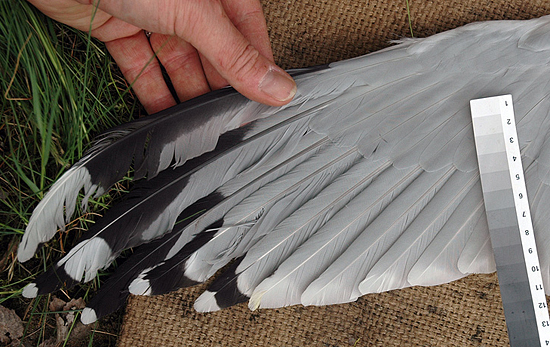
P7 (figure 8, table 6-7)
Basically, the characters to be looked for in P7 are the same as those in P8 but the pale tongue is (nearly) always very long in all forms, and is therefore not helpful. The presence of a ’bayonet' is significant, either on P7 or P8, or on both); see table 5. The amount of white on the tongue-tip should also be noted, although the difference is less obvious than in P8. In some birds, the black colour of the outer web not only projects in a ’bayonet’ or pointed wedge along the outer edge but also slightly along the shaft, thus creating a rather forked or ’V’-shaped pattern (eg, plate 228).
| % NF smithsonianus | 38.4 |
35.8 |
22.0 |
3.8 |
| % argenteus | 1.1 |
50.9 |
20.6 |
27.4 |
| % argentatus | 5.6 |
44.4 |
27.8 |
22.2 |
| % E-Baltic Herring Gull | 6.1 |
71.4 |
12.2 |
10.2 |
FIGURE 8 Variation in pattern of P7 in herring gulls (Peter Adriaens). Percentages refer to the shape of the black pattern on the outer web. Here, for instance, it is stated that 38.4% in our sample of NF smithsonianus showed a black |
||||
TABLE 7 Extent of white on tongue-tip of P7 |
|||
| P7 | % of birds with thin white tongue-tip (crescent-shaped) |
% of birds with broad white tongue-tip (large, rounded spot) |
Total (%) |
| NF smithsonianus | 54 |
46 |
100 |
| argenteus | 84 |
11 |
95 |
| argentatus | 50 |
50 |
100 |
| Eastern Baltic Herring Gull | 91 |
9 |
100 |
P6 (figure 9)
The shape of the black mark is important. The black band was always complete in our sample of NF smithsonianus (in some birds of European forms, especially in argentatus, there is sometimes only an incomplete black band), and the pattern was usually sharply pointed. It is pointed along the inner edge, along the shaft, and along the outer edge, so that the pattern tends to resemble a sort of drawn out ’W’ (see figure 9a and percentages below it). In quite a few European birds, the black band is clearly broader, lacking the three pointed wedges, and showing an oblique, rounded or straight upper border on the outer web (figure 9b and 9c).
| % NF smithsonianus | 95.0 |
4.4 |
0.6 |
| % argenteus | 62.5 |
8.6 |
29.1 |
| % argentatus | 55.6 |
33.3 |
11.1 |
| % E-Baltic Herring Gull | 51.3 |
35.1 |
13.5 |
FIGURE 9 Variation in pattern of P6 in herring gulls (Peter Adriaens). Percentages refer to the shape of the black pattern. Here, for instance, it is stated that 95% in our sample of NF smithsonianus showed a rather drawn-out 'W-pattern', being sharply pointed along the outer edge and the shaft, as illustrated in figure 9a. (click on image for larger view) |
|||
P5 (figure 10, table 8)
The shape of the black mark (when present) is important, even more so than in P6. The majority of NF smithsonianus in our sample had a complete, uninterrupted black band, while this is less frequently seen in European birds. In those NF smithsonlanus with a complete black band, there are normally three pointed wedges (as in P6), creating a nice symmetrical
’W’-pattern (see figure l0a and percentages below it). In birds in which the black band is interrupted, or entirely confined to the outer web, two very pointed wedges usually remain, creating a forked or ’U'-shaped pattern (figure 10b). In argenteus, the common pattern is that of a thick black spot entirely confined to the outer web - which is only rarely seen in NF smithsonianus (see figure 10e). Of those argenteus with a complete black band in our sample, only a minority showed a distinct ’W'-pattern. In argentatus, black markings are commonly absent altogether (figure 10c), No birds in our sample had a distinct, complete ’W’. In Eastern Baltic Herring Gulls, the pattern on P5 is quite variable.
| % NF smithsonianus | 70.2 |
16.8 |
5.2 |
2.8 |
2.0 |
| % argenteus | 6.8 |
3.4 |
16.8 |
15.2 |
47.2 |
| % argentatus | 0.0 |
22.2 |
52.8 |
2.8 |
22.2 |
| % E-Baltic Herring Gull | 12.7 |
22.2 |
28.1 |
15.8 |
20.6 |
FIGURE 10 Variation in pattern of P5 in herring gulls (Peter Adriaens). Percentages refer to the combination of shape and extent of the black pattern. Here, for instance, it is stated that 70.2% in our sample of NF smithsonianus had an uninterrupted black band (on both webs), which, in addition, was shaped like an almost symmetrical 'W', as illustrated in figure 10a. (click on image for larger view) |
|||||
| TABLE 8 Amount of black on P5 | |
| P5 | % of birds with
complete black band |
| NF smithsonianus | 73 |
| argenteus | 22 |
| argentatus | 3 |
| Eastern Baltic Herring Gull | 30 |
Note: In a smaller sample of adult NF smithsonianus (n=100), Jonsson & Mactavish (2001) recorded 65% with a complete black band on P5. |
|
P4
We checked the presence or absence of black marks on this primary, but did not find any significant differences. In all forms that we examined, a variable black mark on the outer web of P4 may occur in a very small proportion of birds (c 2%). In addition, we also found one NF
smithsonianus and one eastern Baltic Herring Gull with an almost complete but thin, black band across both webs.
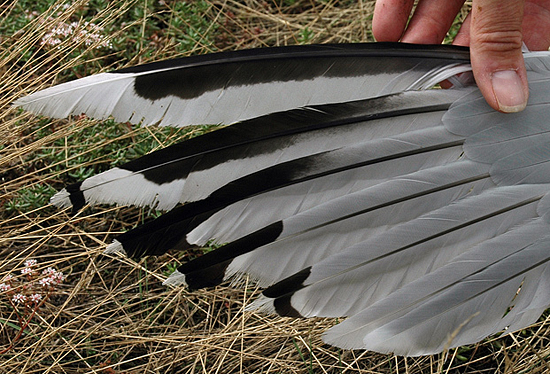
above: European Herring Gull NLA 5.363.004 male adult, Moerdijk, the Netherlands, 12 July 2005 (T. & M. Muusse). Breeding argenteus, resembling 'northern argentatus'. Note the large white mirror on p9, prominently covering both webs and note absence of 'bayonets' on p7-8.
below: Eastern Baltic Herring Gull Larus argentatus, adult, Wloclawek, Poland,
spring 2002 (Grzegorz Neubauer & Magda Zagalska). An example of a European bird with a long, rectangular grey
tongue on p10, quite similar to NF smithsonianus. Note, however, the absence of black marks near the tip of p10,
and the large white mirror on p9 – obviously covering both webs. There do not seem to be 'bayonets' on p7-8,
though the pattern on p8 is partly hidden under p9 here. There are no black marks on p5. Mantle colour can be of
additional help: in a sample of 32 Polish European Herring Gulls (caught and ringed), it was perceived as a mean
value of 5.63 on the Kodak grey-scale (Grzegorz Neubauer & Magda Zagalska pers comm).

Conclusion: diagnostic combinations
While every marked primary of adult NF smithsonianus is often subtly different from the corresponding one in European forms, there is much variation. It is only when the patterns are combined that they give the wing-tip a unique character. Ideally, all primaries should have a typical pattern, and other characters such as structure (’jizz’), head streaking and bill pattern should look right, but if this is not entirely the case, there are at least two minimal combinations that can be used.
First, a very basic one is the combination of P10 and P5: a pattern as in figure 5a (broad, long, almost rectangular tongue) regularly goes with the pattern of figure 10a (complete black ’W’) in NF smithsonianus (52%), while this exact combination was not found in our samples of
argenteus and argentatus. However, it was present in three Eastern Baltic Herring Gulls (c 4%). In European forms, a long tongue on P10 usually excludes a complete black band on P5; some intergrades argenteus >< argentatus, a few Eastern Baltic Herring Gulls, and a few hybrids argentatus x Pontic Gull do combine this tongue with a complete black band on P5 but the shape of the tongue and the shape of the black band are usually (not always!) different from those in typical NF smithsonianus. Also, check the amount of black between the white mirror and tip of P10; European Herring Gulls with a long, broad tongue here (as in figure 5a) usually show little or no black near the tip - and such birds apparently ’never’ show an uninterrupted black band across both webs. Nevertheless, we would strongly advise to check other characters as well, such as the presence of a ’bayonet’, the extent of white on tongue-tips, and so on.
Second, if the black band on P5 is not complete, identification is more complicated but may still be possible. It should be established that at least all of the following characters are present, before a conclusive identification can be reached: 1 P10 with a long, broad, almost rectangular tongue (as in figure 5a); 2 mirror on P9 confined to inner web, or no mirror at all (figure 6a,c,d; 6a being most typical); 3 ’bayonet’ on either P7 or P8, or on both (figures 7a and/or 8a); 4 white tongue-tip on inner web of P8; at least a thin white crescent but preferably a large, rounded, white spot (figure 7a); and 5 complete black band on P6, which is sharply pointed at least along the outer edge, but preferably also along the shaft and the inner edge (tending towards a ’W’-pattern; cf figure 9a). In our sample of NF smithsonianus, 41% showed the combination of the above five criteria, regardless of their pattern on P5. The same combination was not found in our sample of European forms.
Any potential adult smithsonianus in Europe that does not meet these criteria, should be left
unidentified, in our opinion.
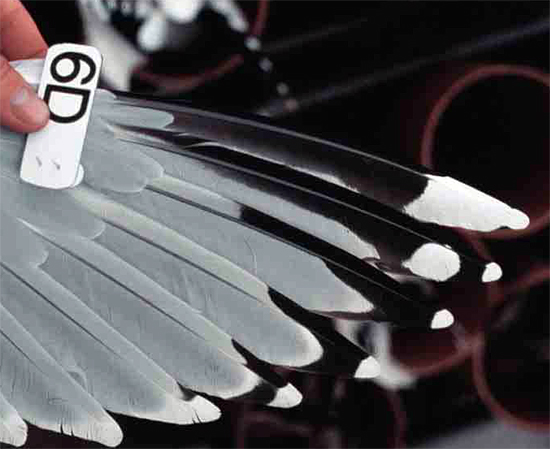
European Herring Gull Larus
argentatus, adult, Germany, date unknown (Andreas
Buchheim). A difficult bird, and therefore a good illustration of why the criteria need to be very strict. Of all
the European birds in our samples, this one was closest
to meeting the minimal requirements for Newfoundland Herring Gull L smithsonianus. Note, however, that
the pattern on p6 is not typical (compare with figure 9; the black band tends more towards pattern 9b than 9a, as it
is more asymmetrical – clearly more black on the outer web than on the inner web –, with a distinct 'step' on the
shaft, and is less pointed along the outer edge; especially the step on the shaft is wrong for NF smithsonianus).
There are no obvious 'bayonets', only an indistinct one on the outer web of p8. The outer web of p9 is entirely
black all the way up to the primary coverts (note that at least one primary covert is missing at the base). Note also
the disproportionate amount of black on p5: there is a rather thick black spot on the outer web, but nothing on the
inner web. This pattern corresponds with figure 10e, which is shown by only a few NF smithsonianus (2%).
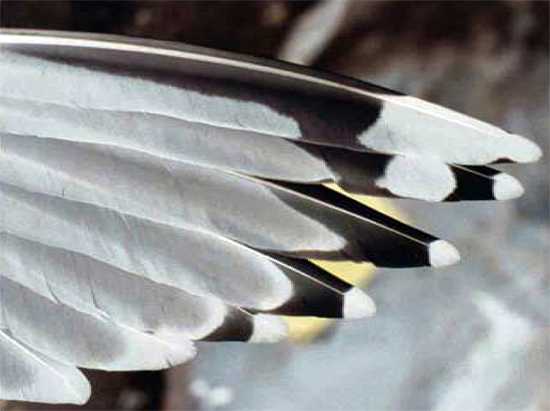
East Coast birds
 American Herring Gull (smithsonianus) adult K68 May 23 2011 & February & March 2012, Hampton Beach, NH. Picture: Keith Mueller & Jon Worthen.
American Herring Gull (smithsonianus) adult K68 May 23 2011 & February & March 2012, Hampton Beach, NH. Picture: Keith Mueller & Jon Worthen. American Herring Gull (smithsonianus)7cy-8cy M54 (formerly C45) 2011 & 2012, Hampton Beach, NH. Picture: Keith Mueller & Jon Worthen.
American Herring Gull (smithsonianus)7cy-8cy M54 (formerly C45) 2011 & 2012, Hampton Beach, NH. Picture: Keith Mueller & Jon Worthen. American Herring Gull (smithsonianus) M82 adult, June 26 2015, Hampton Beach State Park, NH. Picture: Charlee Breen.
American Herring Gull (smithsonianus) M82 adult, June 26 2015, Hampton Beach State Park, NH. Picture: Charlee Breen. American Herring Gull (smithsonianus) V18 4th cycle (5CY), June 26 2015, Hampton Beach State Park, NH. Picture: Charlee Breen.
American Herring Gull (smithsonianus) V18 4th cycle (5CY), June 26 2015, Hampton Beach State Park, NH. Picture: Charlee Breen. American Herring Gull (smithsonianus) Z68 3rd & 5th cycle (4CY & 6CY), February 2016 & March 2018, Stratford, CT. Picture: Donna Caporaso & Audubon CT.
American Herring Gull (smithsonianus) Z68 3rd & 5th cycle (4CY & 6CY), February 2016 & March 2018, Stratford, CT. Picture: Donna Caporaso & Audubon CT.  American Herring Gull (smithsonianus) VC adult, March 15 2014, Henry's Pool - Hampton, NH. Picture: Jason Lambert.
American Herring Gull (smithsonianus) VC adult, March 15 2014, Henry's Pool - Hampton, NH. Picture: Jason Lambert.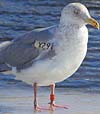 American Herring Gull (smithsonianus) Z4 / tag X29 adult, March 07 2014, ZV Lake, Newfoundland. Picture: Lisa de Leon.
American Herring Gull (smithsonianus) Z4 / tag X29 adult, March 07 2014, ZV Lake, Newfoundland. Picture: Lisa de Leon. American Herring Gull (smithsonianus) adult, March 18 2009, Ocean City inlet, Worcester Co., MD. Picture: Frode Jacobsen.
American Herring Gull (smithsonianus) adult, March 18 2009, Ocean City inlet, Worcester Co., MD. Picture: Frode Jacobsen. American Herring Gull (smithsonianus) adult, March 30 2009, Cape Cod, MA. Picture: Jim Frazier.
American Herring Gull (smithsonianus) adult, March 30 2009, Cape Cod, MA. Picture: Jim Frazier. American Herring Gull (smithsonianus) adult, March 10 2012, Rockland Harbor, Rockland, Maine. Picture: Jonathan Mays.
American Herring Gull (smithsonianus) adult, March 10 2012, Rockland Harbor, Rockland, Maine. Picture: Jonathan Mays. American Herring Gull (smithsonianus) adult, March 23 2007, Dartmouth, Nova Scotia, Canada. Picture: P.J. Gergely.
American Herring Gull (smithsonianus) adult, March 23 2007, Dartmouth, Nova Scotia, Canada. Picture: P.J. Gergely. American Herring Gull (smithsonianus), adult, March 29 2012, Salisbury, MA. Picture: Suzanne Sullivan.
American Herring Gull (smithsonianus), adult, March 29 2012, Salisbury, MA. Picture: Suzanne Sullivan. American Herring Gull (smithsonianus), adult, March 10 2012, Gloucester, MA. Picture: Suzanne Sullivan.
American Herring Gull (smithsonianus), adult, March 10 2012, Gloucester, MA. Picture: Suzanne Sullivan. American Herring Gull (smithsonianus), adult, March 10 2012, Gloucester, MA. Picture: Suzanne Sullivan.
American Herring Gull (smithsonianus), adult, March 10 2012, Gloucester, MA. Picture: Suzanne Sullivan. American Herring Gull (smithsonianus) adult, April 25 2014, Oceanville, NJ. Picture: Brian Kushner.
American Herring Gull (smithsonianus) adult, April 25 2014, Oceanville, NJ. Picture: Brian Kushner.South Coast birds
 American Herring Gull (smithsonianus) adult, March 19 2009, Rockport Texas. Picture: Tripp Davenport.
American Herring Gull (smithsonianus) adult, March 19 2009, Rockport Texas. Picture: Tripp Davenport.birds in Europe
 American Herring Gull (smithsonianus) adult, Galway, County Galway, March 02 2008. Picture: Richard Bonser.
American Herring Gull (smithsonianus) adult, Galway, County Galway, March 02 2008. Picture: Richard Bonser. Herring Gull (argenteus) (sub) adult, March 04 2011, Iceland. Picture: Ómar Runólfsson.
Herring Gull (argenteus) (sub) adult, March 04 2011, Iceland. Picture: Ómar Runólfsson.


